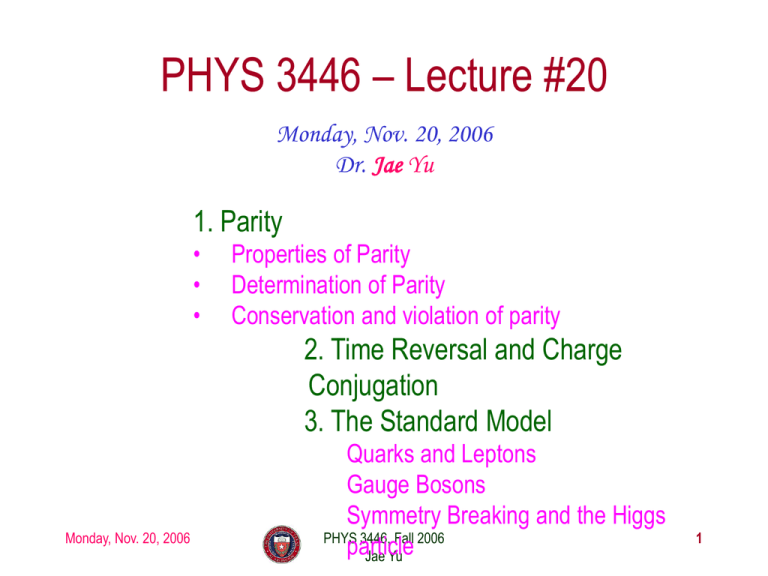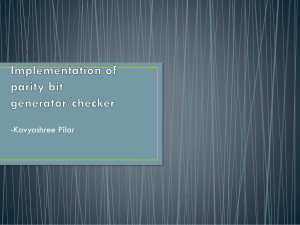Monday, Nov. 20, 2006
advertisement

PHYS 3446 – Lecture #20 Monday, Nov. 20, 2006 Dr. Jae Yu 1. Parity • • • Properties of Parity Determination of Parity Conservation and violation of parity 2. Time Reversal and Charge Conjugation 3. The Standard Model Monday, Nov. 20, 2006 Quarks and Leptons Gauge Bosons Symmetry Breaking and the Higgs PHYS 3446, Fall 2006 particle Jae Yu 1 Announcements • 2nd term exam – – • Workshop on Saturday, Dec. 2 – – • In class, this Wednesday, Nov. 22 Covers: Ch 4 – CH11 10am – 5pm CPB 303 and other HEP areas Write up due: Before class Wednesday, Dec. 6 Monday, Nov. 20, 2006 PHYS 3446, Fall 2006 Jae Yu 2 Write Up Requirements and Evaluation • • Due date: Prior to class on Wednesday, Dec. 6 Requirements – – Need to put the name(s) of the person(s) who wrote the given sections Professionally prepared in MS words • • – – All contents on the template and more should be contained in the write up Pictures, diagrams and photos should be added w/ appropriate figure captions numbered in order of appearance. The captions should go at the bottom of the figure. References must be indicated throughout the text in order of appearance. They must be properly matched in the list of bibliography at the end of the document. Tables must be added and numbered in order of appearance. The caption should go on top of the table. – – • No spelling or grammar mistakes The style of the write up should be unified so that it looks like written by one person Key evaluation points – – – – Quality of the document – 30% Content and organization of the document – 20 % Satisfaction of the above requirements – 25% Thoughtfulness, usefulness and relevance of contents of the document – 25% • E.g. The contact information of vendors must be usable for the construction Monday, Nov. 20, 2006 PHYS 3446, Fall 2006 Jae Yu 3 Presentation Requirements • Requirements – Professionally prepared using power points • – Each presentation must be 10min (presentation) + 2min (question and answer) Must have the following components: – • • • • • • • Need your presentations 30 min prior to the class General Introduction Motivation Design considerations and requirements Design features Test of design and its functionality Conclusions and future improvements Key evaluation points – 25% each – – – – Quality of the slides Content and organization of the slides Knowledge on presentation material – answers to questions Manner of presentation Monday, Nov. 20, 2006 PHYS 3446, Fall 2006 Jae Yu 4 Presentation Schedule • Monday, Dec. 4: 1. 2. 3. 4. 5. 6. • Wednesday, Dec. 6: 1. 2. 3. 4. 5. Monday, Nov. 20, 2006 Shane Daniel Heather Justin Cassie Layne Pierce Jessica James Matt Lauren PHYS 3446, Fall 2006 Jae Yu 5 Gauge Fields and Mediators • To keep local gauge invariance, new particles had to be introduced in gauge theories – U(1) gauge introduced a new field (particle) that mediates the electromagnetic force: Photon – SU(2) gauge introduces three new fields that mediate weak force • Charged current mediator: W+ and W• Neutral current: Z0 – SU(3) gauge introduces 8 mediators (gluons) for the strong force • Unification of electromagnetic and weak force SU(2)xU(1) gauge introduces a total of four mediators – Neutral current: Photon, Z0 – Charged current: W+ and WMonday, Nov. 20, 2006 PHYS 3446, Fall 2006 Jae Yu 6 Parity • The space inversion transformation (mirror image) Switch right- handed coordinate system to left-handed ct x y z Parity ct x y z • How is this different than normal spatial rotation? – Rotation is continuous in a given coordinate system • Quantum numbers related to rotational transformation are continuous – Space inversion cannot be obtained through any set of rotational transformation • Quantum numbers related to space inversion is discrete • Parity is an example of the discrete transformation Monday, Nov. 20, 2006 PHYS 3446, Fall 2006 Jae Yu 7 Properties of Parity • Position and momentum vectors change sign under space inversion r P r p mr P mr p • Where as their magnitudes do not change signs r r r P r r r r r p P p p p p p p p • Vectors (particles w/ JP=1-) change signs under space-inversion while the scalars (particles w/ JP=0+) do not. Monday, Nov. 20, 2006 PHYS 3446, Fall 2006 Jae Yu 8 Properties of Parity • Some vectors, however, behave like a scalar – Angular momentum L r p P r p r p L – These are called pseudo-vectors or axial vectors (particles w/ JP=1+) • Likewise some scalars behave like vectors a b c P a b c a b c – These are called pseudo-scalars (particles w/ J =0 ) P - • Two successive application of parity operations must turn the coordinates back to original 2 – P P P P – The possible values (eigen values) of parity, P, are +1 (even) or -1 (odd). • Parity is a multiplicative quantum number Monday, Nov. 20, 2006 PHYS 3446, Fall 2006 Jae Yu 9 Parity • Two parity quantum numbers – Intrinsic parity: Bosons have the same intrinsic parities as their anti-particles while fermions have opposite parity than its antiparticle (odd) Why? – Parity under spatial transformation that follows the rule: P=(-1)l • l is the orbital angular momentum quantum number • Are electromagnetic and gravitational forces invariant under parity operation or space inversion? 2 d – Newton’s equation of motion for a point-like particle m r F dt 2 – For electromagnetic and gravitational forces we can write the 2 forces m d r F C rˆ , and thus are invariant under parity. dt 2 Monday, Nov. 20, 2006 r2 PHYS 3446, Fall 2006 Jae Yu 10 Determination of Parity Quantum Numbers • How do we find out the intrinsic parity of particles? – Use observation of decays and production processes – Absolute determination of parity is not possible, just like electrical charge or other quantum numbers. – Thus the accepted convention is to assign +1 intrinsic parity to proton, neutron and the L hyperon. • The parities of other particles are determined relative to these assignments through the analysis of parity conserving interactions involving these particles. • L hyperon is always produced with a K in pair. So one can only determine parity of K if parity of L is fixed. Monday, Nov. 20, 2006 PHYS 3446, Fall 2006 Jae Yu 11 Parity Determination • When the parity is conserved, it can restrict decay processes that can take place. • Consider a parity conserving decay: AB+C – Conservation of angular momentum requires both sides to have the same total angular momentum J. – If B and C are spinless, their relative orbital angular momentum ( l ) must be the same as J(=l+s). – Thus conservation of parity implies that l J A BC 1 BC 1 – If the decay products have spin zero, for the reaction to take place we must have A BC between the intrinsic parities Monday, Nov. 20, 2006 PHYS 3446, Fall 2006 Jae Yu 12 Parity Determination • Therefore, the allowed decays must have 0 0 0 0 0 0 0 0 0 – Where the spin intrinsic parity of the particles are expressed as JP • Are the following decays allowed under parity conservation? 0 0 0 0 0 0 0 0 0 Monday, Nov. 20, 2006 PHYS 3446, Fall 2006 Jae Yu 13 Example 1, p- parity • Consider the absorption of low energy p- in deuterium nuclei p d nn • The conservation of parity would require p d 1 nn 1 li lf • What are the intrinsic parity of deuteron and of the two neutrons? – Deuteron: +1; Neutrons: +1 p 1l f li 1l f li • This capture process is known to proceed from an l li=0 state, thus we obtain p 1 Monday, Nov. 20, 2006 PHYS 3446, Fall 2006 Jae Yu f 14 Example 1, p- parity, cont’d • Since spin of the deuteron Jd=1, only a few possible states are allowed for the final state neutrons 1) nn J 1, s 1, l f 0 or 2 2) nn J 1, s 1, l f 1 3) nn J 1, s 0, l f 1 or • Since the two neutrons are identical fermions, their overall wave functions must be anti-symmetric due to Pauli’s exclusion principle leaves only (3) as the possible solution • Making pion a pseudo-scalar w/ intrinsic parity p 1 Monday, Nov. 20, 2006 PHYS 3446, Fall 2006 Jae Yu 15 Parity Violation • Until the observation of “tq” puzzle in cosmic ray decays late 1950’s, parity was thought to be conserved in (symmetry of) all fundamental interactions • The t and q particles seem to have identical mass, lifetimes, and spin (J=0) but decay differently 2 0 1 q p p q p p 1 t p p p 0 t p p p 1 1 3 • These seem to be identical particles. Then, how could the same particle decay in two different manner, violating parity? Monday, Nov. 20, 2006 PHYS 3446, Fall 2006 Jae Yu 16 Parity Violation • T.D. Lee and C.N. Yang studied all known weak decays and concluded that there were no evidences of parity conservation in weak decays – Postulated that weak interactions violate parity – See, http://ccreweb.org/documents/parity/parity.html for more interesting readings • These turned out to be Kp 2 K p p p Kp 3 K p p 0 • Parity is conserved in strong and EM interactions but not in weak interactions w/ very little degree of violation Monday, Nov. 20, 2006 PHYS 3446, Fall 2006 Jae Yu 17 Time Reversal • Invert time from t - t . t T t r T r p mr T mr p L r p T r p r p L • How about Newton’s equation of motion? d 2r C m 2 F 2 rˆ dt r 2 2 d r d T m 1 2 m 2r F C2 rˆ dt dt r 2 – Invariant under time reversal Monday, Nov. 20, 2006 PHYS 3446, Fall 2006 Jae Yu 18 Charge Conjugate • Conversion of charge from Q - Q . Q C Q q q E c 2 rˆ C c 2 rˆ E r r ds rˆ ds rˆ B cI C c I B 2 2 r r • Under this operation, particles become antiparticles • What happens to the Newton’s equation of motion? d 2r C m 2 F 2 rˆ dt r C d 2r q2 2 m 2 2 1 rˆ F dt r – Invariant under charge conjugate Monday, Nov. 20, 2006 PHYS 3446, Fall 2006 Jae Yu 19








